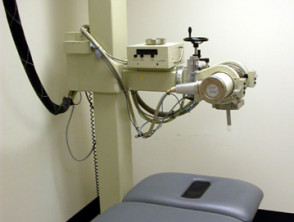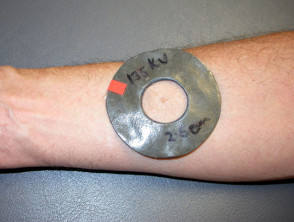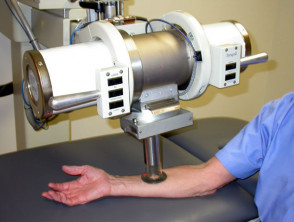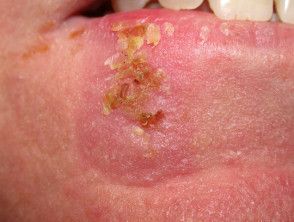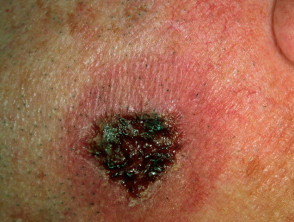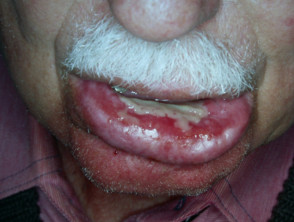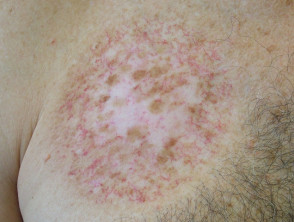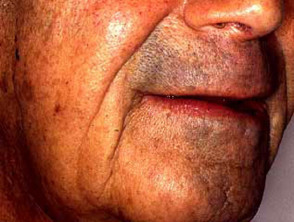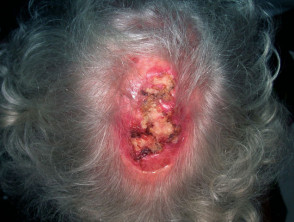What is radiation therapy?
Radiation therapy (or radiotherapy) is the treatment of cancer using radiation. During radiation treatment, radiation is directed to the target tissue and transmits energy that damages and destroys the cancer cells. It does this by damaging the genetic material of the cells which triggers cell death. The radiation damages genetic material in both normal and malignant cells and does not discriminate between them. However, normal cells are able to recover from the damage, whilst the cancer cells do not. Radiation therapy aims to maximize the number of cancer cells destroyed, while minimizing the damage to nearby normal cells.
Radiation therapy for skin cancer
The main type of radiation used for the treatment of skin cancers are x-rays. X-rays can be generated with different energy levels. High energy x-rays are able to penetrate deep into the body, and are used to treat internal cancers. In contrast, low energy x-rays do not penetrate very deep into the body and transmit most of their energy into the skin and are therefore used for the treatment of skin cancers. These low energy x-rays are often called superficial or orthovoltage x-rays. In addition, electron beams and gamma rays are other forms of radiation that are sometimes used to treat skin cancers.
When is radiation therapy used?
Radiation therapy is not suitable for all types of skin cancers. Some of the factors affecting whether radiation therapy can be used include:
- Type of cancer
- Site of the cancer
- Previous use of radiation therapy
- Suitability of other treatments
- Patient preference
Type of cancer
Different cancers vary in their sensitivities to radiation induced damage, which influences how successful the radiation therapy will be. For example, melanomas are less sensitive to radiation, and are rarely treated with radiation therapy. Skin cancers which are relatively sensitive to radiation and commonly treated with radiation therapy include:
- Basal cell carcinoma
- Squamous cell carcinoma
- Cutaneous lymphomas
- Kaposi sarcoma
- Merkel cell carcinoma
Site of the cancer
Radiation therapy is often used in sites in which surgery may be difficult, such as the eyelids. Some areas of the body are more likely to develop side effects from radiation therapy, such as the lower legs, and in these areas other treatments may be preferred.
Previous use of radiation therapy
If a site has previously been treated with radiation, then further radiation therapy cannot be used. If a skin recurs after radiation treatment then other treatments, such as surgical excision are usually preferred.
Other factors
In addition to the factors above, there are a number of other factors that determine the suitability of radiation therapy.
- The size of the skin cancer
- Contraindications to surgery
Administration of radiation therapy
In New Zealand most radiation therapy is supervised and prescribed by specially trained radiation oncologists, based in the main clinical centers (Auckland, Hamilton, Palmerston North, Wellington, Christchurch and Dunedin). Most radiation therapy is given on an outpatient basis, involving a number of visits.
The initial visits will typically involve planning how the radiation therapy is to be administered. At this point the radiation oncologist determines the exact area to be irradiated, and the type and dose of radiation that will be used.
The dose of radiation can be given all at once, but it is usually divided into several smaller doses, called fractions. This is done as the time between doses (fractions) allow the normal cells to recover from the radiation induced damage. This ultimately reduces side effects and allows a higher total dose of radiation to be safely used. For most skin cancers a total of 10–25 fractions of radiation treatment are administered. The radiation therapy is administered by a specially trained radiation therapist, and each fraction usually takes 15–20 minutes to administer. Fractions are usually given on a daily basis (Monday to Friday); hence a full treatment course can take between 2–5 weeks to complete.
Adverse effects of radiation therapy
Side effects from radiation therapy can be divided into those occurring early (days to weeks) during the treatment and those occurring late (months to years) following the radiation therapy.
Early side effects
Skin that has been exposed to the radiation can become red and warm, like sunburn (acute radiation dermatitis). It can sometimes peel and become moist and oozy. The affected skin may ulcerate, especially when mucous surfaces are affected.
Area treated 2 weeks prior to photographs
Late side effects
The following side effects can occur in the treated areas:
- Chronic radiation dermatitis
- Skin atrophy, causing the skin to appear thin and pale.
- Telangiectases, which are visible, small spidery blood vessels.
- Increased pigmentation
- Alopecia (hair loss)
- Non-healing ulcer (rare)
- A different type of skin cancer can develop in the treated area (very rare)
Longterm effects of radiotherapy
Treatment of adverse effects
Early adverse effects are often treated with the following:
- Weak topical steroids
- Emollients, such as cetomacrogol cream
- Analgesics
- Reduced dose of radiation (if severe)
Effectiveness of radiation therapy
The success rates for radiation therapy vary depending on the type and size of the cancer and the type of treatment used. For small, uncomplicated basal cell cancers and squamous cell cancers the success rates are similar to surgical excision, with 5 year cure rates of approximately 90%.
However, a recent review found that there have been very few research studies on radiotherapy for skin cancer.
